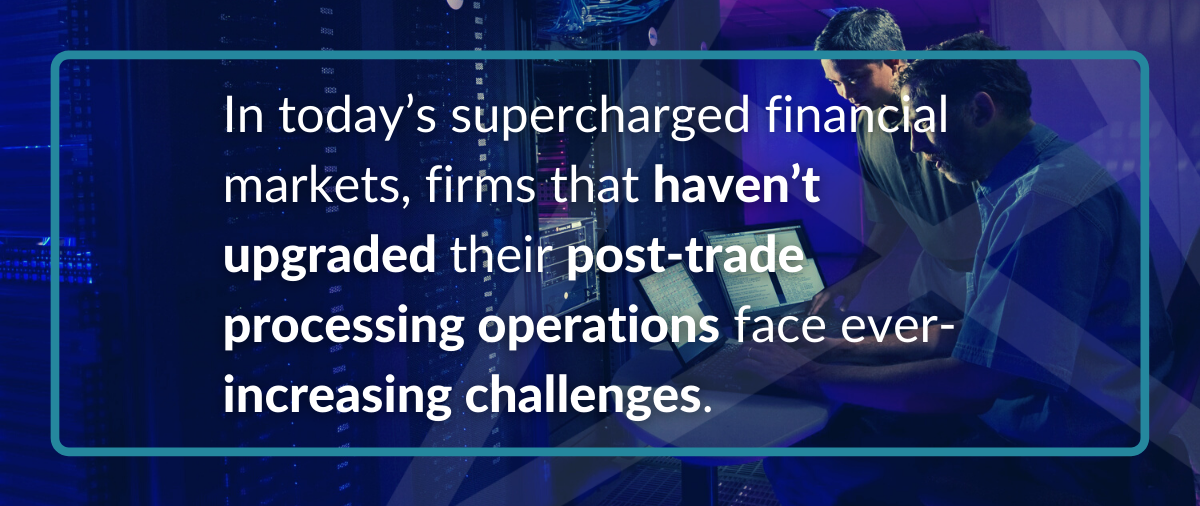In today’s supercharged financial markets, firms that haven’t upgraded their post-trade processing operations face ever-increasing challenges. Trading volume has expanded significantly, in large part due to electronic and algorithmic trading. The regulators have mandated shorter settlement periods, and while that has the benefit of reducing credit and market risk, including the risk of default by a counterparty, it has increased the strain on post-trade processing systems. Companies that wish to upgrade legacy systems face significant expense in doing so. However, there’s a solution to the problem of updating systems in a cost-efficient manner.
Depending on a legacy system while cutting costs can’t lead to sustainable growth
Traditionally, firms have depended on internal purpose-built systems or third-party providers of post-trade processing services to meet their needs. Rapid growth in trading volume puts significant stress on legacy systems, as well as third-party providers, and has made both options less financially feasible. As the business grows, firms need to maintain or increase margins for growth to be sustainable. Cost-cutting alone can’t solve this problem because post-trade processing capacity must expand to support growth. The best option for addressing the issue can be found in the cloud.
Migrating to the Cloud is only the first step
While migrating post-trade processing to a cloud offering is a critical first step, it does not offer a magical solution for managing costs. The process has to be optimally scaled. With a legacy system, assume that revenue increases in correlation with the volume of trades processed. When the system reaches full capacity, it’s scaled horizontally. It’s possible to manage margin as long as the incremental cost per trade processed is lower than the increase in revenue. If capacity is increased without maximizing processing efficiency, margin can suffer.
Cloud providers offer flexible terms that can optimize costs and efficiency
A firm that opts to scale processing on a cloud-native platform can pursue several strategies to balance capacity with scale-up costs. For example, cloud providers typically offer pricing options based on usage profiles. It may be possible to reserve capacity for the long-term, which can significantly reduce costs. Unused capacity can also be resold. Serverless hosting, if workable, can allow firms to enjoy usage-based pricing without paying for hosting. Depending on needs, flexible scaling, coupled with a variety of pricing and hosting options, can lead to significant cost savings.
Manage your migration wisely
While the cloud offers myriad advantages, a poorly managed migration can erode the benefit. Migration needs to be approached with a clearly articulated strategy and the ultimate goal in mind. As a first step, some firms choose to rehost legacy systems on the cloud, which is a softer approach toward revamping processing architecture. Subsequently, the firm reduces dependence on legacy systems over time. As the migration process continues, capabilities can be rationalized, and the developer’s time can be used judiciously to efficiently implement the ultimate solution.
There are many reasons to consider migrating post-trade processing to the cloud, whether you’re working with a developer to implement your own solution or are considering a SaaS solution. As the pandemic continues, the ability to work remotely remains essential and cloud-based systems remove ties to a physical location. [t4] Moreover, the future of work no longer looks as though it did pre-pandemic. Remote work is here to stay, and a firm’s technology stack must be aligned to long-term human capital needs.
Divesting hardware and the staff necessary to maintain that hardware yields significant cost savings, and efficient scaling becomes significantly easier in the cloud. Finally, the costs for cloud-based systems can be moved onto the P&L, offering further financial benefit. Moving processing onto the cloud yields many benefits but should be managed carefully to get the most bang for the buck.
___
About the Author
Rebecca Baldridge, CFA, is an investment professional and financial writer with more than 20 years of experience in creating content and research for asset managers, investment banks, brokers and other financial services clients. She’s worked for some of the biggest names in the industry, including Merrill Lynch Asset Management, JP Morgan Asset Management, BNY Mellon and Franklin Templeton. Rebecca also spent 9 years as an analyst and director of equity research in Moscow, working for several Russian banks. In late 2019, she founded Quartet Communications, a boutique communications firm serving financial services clients. Her writing has been published in outlets including Pensions & Investments, MSNBC.com, Inc. magazine, and Investopedia.com. She holds a B.A. in Russian from Purdue University and an M.S. in Finance from the Krannert Graduate School of Management at Purdue.
